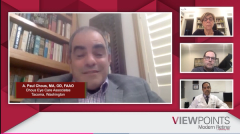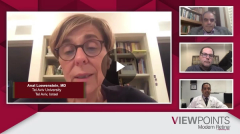
Overview of diabetic eye disease
Episodes in this series

Rishi Singh, MD: Hello and welcome to this Ophthalmology Times®, Ophthalmology Times Europe®, Optometry Times®, and Modern Retina Viewpoints, “Updates in Diabetic Retinopathy and Diabetic Macular Edema.”
I am Dr Rishi Singh from the Cleveland Clinic in Cleveland, Ohio. It’s my pleasure to have the following panelists joining me today for the program. First, Dr Anat Loewenstein, professor of ophthalmology from Tel Aviv University in Tel Aviv, Israel; Dr Paul Chous, an optometrist specializing in diabetes eye care from Tacoma, Washington; and Dr Steven Ferrucci, chief of optometry at Sepulveda VA [United States Department of Veterans Affairs] Hospital in North Hills, California.
Today we are going to discuss a number of topics pertaining to diabetic eye disease, including diagnosis, clinical manifestations, some of the traditional treatment options, and some of the new potential emerging areas on the horizon.
Let’s get started for our first topic. In this segment, we’re going to provide an overview of diabetic eye disease. Diabetic eye disease is the leading cause of blindness in working-age adults. We want to hear from our panelists about what diabetic eye disease is and what diabetic retinopathy is in particular. We’ll start off with Dr Steve Ferrucci. Steve, can you help us understand better for the laymen, and for even the clinician, what is diabetic eye disease? How does it happen? How does diabetic macular edema form?
Steven G. Ferrucci, OD, FAAO: Diabetic retinopathy is damage to the blood vessels that line the inside of the eye, and you essentially experience loss on the pericytes that line the vessel wall. That can lead to problems such as ischemia, leakage, and the accumulation of fluid.
Rishi Singh, MD: Paul, one of the real controversies in our field is how to perform a diabetic eye examination correctly. Can you discuss that in a bit more detail with regards to what the patient should expect, as well as the clinician? What is the standard of care for a diabetes eye examination?
A. Paul Chous, OD, MA, FAAO: An eye examination for any patient has many of the same components, but when it comes to a patient with diabetes, it’s imperative to get a good dilated stereoscopic view of the inside of the eye. Imaging is useful, especially at a baseline examination so you have something to compare. For me, the most important thing is a good case history about glucose control, blood pressure control, and lipids. I like to ask my patients not just about what their A1C [glycated hemoglobin] is today but what their A1C has been over time, because we know there is this phenomenon of metabolic memory. If I have a good sense of where they’ve been in the previous years before I’ve seen them, that’s helpful. It helps me give them better advice about the frequency of examination and what the odds are for them maintaining good vision throughout their lives.
A panel of experts in ophthalmology and optometry review the diagnosis and treatment of diabetic eye disease including emerging agents in the field.
Newsletter
Keep your retina practice on the forefront—subscribe for expert analysis and emerging trends in retinal disease management.





















































